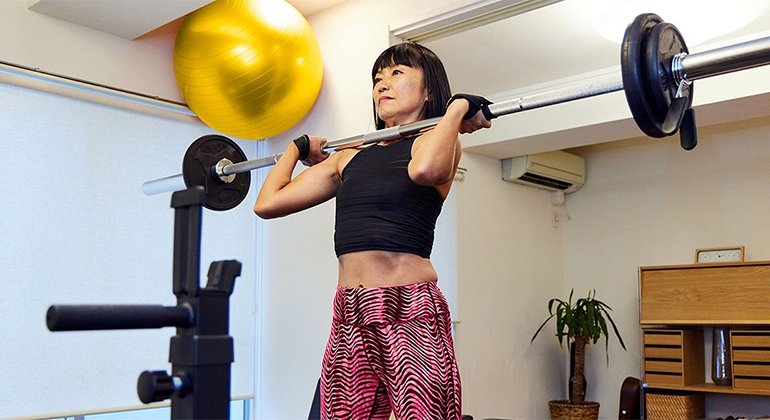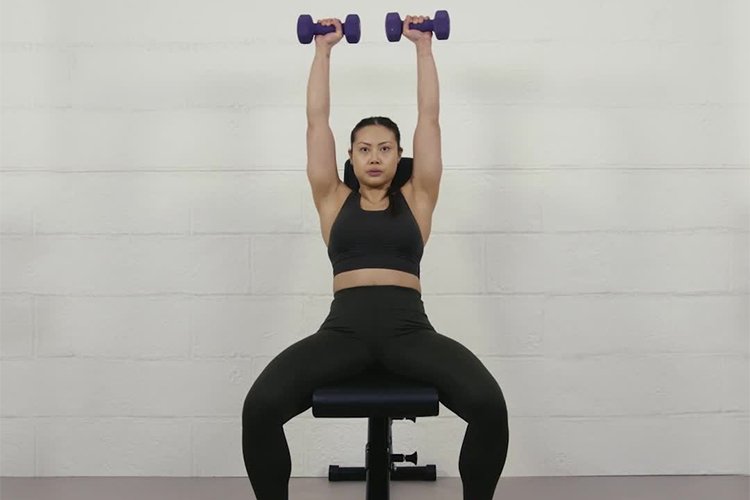
Discover the benefits and techniques of the overhead press, a fundamental strength exercise that improves muscular and functional performance.
Ready to upgrade your workout routine? Learn the overhead press—a classic movement that works the deltoids, triceps, upper pecs, and core.
Also called the shoulder press, strict press, or military press, this exercise is a staple of weightlifting. Whether performed with a barbell or dumbbell, it improves upper body strength, muscle size, coordination, and overhead function.
Master this move and join the pantheon of gym gods and goddesses. Read on to learn how.
Mastering the overhead press starts with proper technique to maximize success and minimize injury. Here’s a step-by-step guide to help you press like a pro:
Start with your grip: Position your hands just outside shoulder width on the barbell. Make sure your grip is tight.
Position the barbell: Start by placing the bar on your shoulders and collarbones and keeping your elbows slightly in front of the bar.
Stance and posture: Stand with your feet shoulder width apart. Tighten your core and keep your back straight.
Start the lift: Inhale and press the bar straight up. Exhale as you do so. Move your head back slightly so the bar passes in front of your face.

Release: Extend your arms fully overhead while the bar is stable. Make sure your torso and legs stay straight and tight.
Return to starting position: Lower the bar back to your shoulders in a controlled manner and prepare for the next rep.
The overhead press isn’t just a show of strength—it’s a foundational exercise with a number of benefits beyond muscle building. Here’s why it makes sense to incorporate this powerful exercise into your workout:
Strengthens shoulders: The overhead press targets your deltoids like few other exercises, working out those coveted shoulder plates and increasing shoulder strength and stability.
Develops upper body: This exercise uses the triceps, upper chest, and back muscles to lift the weight overhead.
Works core: Stabilizing your body under a weight overhead puts your abs and obliques working overtime, resulting in a stronger, more resilient core.
Stimulates metabolism: By engaging multiple major muscle groups, you burn a ton of calories during and after your workout, boosting your metabolism and improving fat loss.
Improves posture and balance: Regularly performing overhead weight presses teaches your body to stabilize under load, improving your balance and posture and making you less prone to injury.

Builds functional fitness: With overhead press training, you’ll find everyday activities like packing luggage or lifting a child easier and safer.
To add variety or adjust the difficulty level of your overhead press, consider these variations:
Push press: Incorporate a slight knee bend and explosive movements to lift heavier weights overhead.
Seated overhead press: Perform the press seated on a bench to remove lower body support and focus more on upper body strength.
Arnold press: Start with dumbbells in front of you, palms facing your shoulders, and rotate your wrists as you press up to engage the shoulder muscles more.
The overhead press is a comprehensive upper body exercise that works the following muscles:
Delta muscles
Triceps
Upper chest muscles
Core muscles
Avoid these common overhead press mistakes to improve your form and effectiveness:
Arching your back: This can cause strain on the lower back. Keep your core tight and keep your spine straight.
Flapping your elbows: This puts unnecessary strain on the shoulders. Keep your elbows slightly in front of the bar.
Using momentum: Avoid rocking your lower body upward; the movement should be strictly and controlled from the shoulders.

It is important to perform the overhead press safely to avoid injury. Here are some tips:
Warm up properly: Get your muscles going with a good warm-up routine, including dynamic stretches and light shoulder-focused exercises.
Pay attention to your grip and form: Safe and correct form is your first line of defense against injury. To start and push yourself straight up, make sure your hands are positioned just outside your shoulders, your wrists are stable, and your elbows are slightly in front of the bar.
Keep your core engaged: Activating your core throughout the lift is essential. It stabilizes your entire body and reduces the risk of compromising your back, especially with heavy loads.
Go at a controlled pace: Rushing your reps increases the chance of losing form and potentially injuring yourself. Raise and lower the weight in a controlled manner to maintain muscle tension and form integrity.
Use a spotter or safety rack: When lifting heavy objects, a spotter can provide additional safety. Alternatively, you can set up safety racks or use a power cage to catch the bar if you lose control.
The overhead press is a powerful tool in your fitness arsenal, perfect for building strength and improving muscle coordination. But remember to warm up, focus on form, and keep your core tight to prevent injury and maximize success.